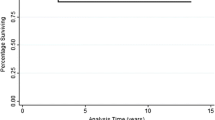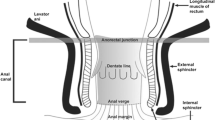Abstract
Background
Surveillance after radiochemotherapy of anal carcinoma (ACa) with curative intent is recommended in guidelines, but data regarding the effectiveness of follow-up are lacking. We aimed to assess the performance of an ACa surveillance program in a real-life setting.
Methods
We retrospectively summarized clinical history, physical findings, and follow-up investigations (endoanal ultrasound, endoscopy, CT scan) obtained during 42 months (±27 months) from 80 patients after radiochemotherapy of ACa.
Results
In 7/80 cases (8.8%) an incomplete response to therapy was identified at or before the 6‑month time point after the end of treatment; 4 of the 7 cases were identified during scheduled follow-up. In 6 cases (7.5%), recurrent disease was found after the 6‑month time point. Recurrence was systemic in 5 cases and local/inguinal in 1 case. In 3 of the 6 cases (50%), recurrence was identified during scheduled follow-up. In one asymptomatic patient, a single liver metastasis was detected during scheduled follow-up and the patient remains free of disease 19 months after surgery. Surveillance resulted in a high rate of false-positive findings (70 findings in 604 investigations), of which only 14 could be confirmed.
Conclusion
Scheduled follow-up after treatment of ACa detected recurrent disease at systemic sites, enabling potentially curative treatment in a single case. Effectiveness of abdominal imaging during follow-up after ACa treatment should be tested in a prospective trial.
Zusammenfassung
Hintergrund
Nach kurativ intendierter kombinierter Radiochemotherapie beim Analkarzinom (ACa) wird von den Guidelines eine Nachsorge empfohlen, die Datenlage hierzu ist jedoch mangelhaft. Ziel unserer Studie war es, die Wertigkeit der Nachsorge beim ACa in einem „Real-life“-Setting zu evaluieren.
Methoden
Es erfolgte die retrospektive Aufarbeitung der Nachsorge inklusive Anamnese, klinischer Untersuchung und Nachsorgeuntersuchungen (untere Endosonographie, Endoskopie, Computertomographie Abdomen/Becken) während 42 (±27) Monaten bei 80 Patienten nach kurativer Radiochemotherapie eines ACa.
Ergebnisse
Bei 7/80 Patienten (8,8 %) wurde bei oder vor der 6‑Monats-Kontrolle nach Ende der Radiochemotherapie ein inkomplettes Ansprechen dokumentiert; 4 der 7 Fälle wurden aufgrund geplanter Nachsorgeuntersuchungen entdeckt. In 6 Fällen (7,5 %) wurde nach der 6‑Monats-Kontrolle ein Rezidiv festgestellt. Die Rezidive waren Fernmetastasen in 5 Fällen und ein lokoregionäres Rezidiv in einem Fall. In 3/6 Fällen (50%) wurden die Rezidive während der geplanten Nachsorgeuntersuchung entdeckt. Bei einem asymptomatischen Patienten wurde in der Nachsorge eine singuläre Lebermetastase diagnostiziert; nach Resektion blieb der Patient während der restlichen Nachsorge von 19 Monaten rezidivfrei. Die Nachsorge führte zu einer hohen Rate an falsch-positiven Befunden (70 Befunde in 604 Untersuchungen), welche nur in 14 Fällen als wirklich relevant bestätigt werden konnten.
Schlussfolgerung
Mit der geplanten Nachsorge nach kurativer Radiochemotherapie beim ACa konnten systemische Rezidive entdeckt werden, die zumindest in einem Fall potenziell kurativ behandelt werden konnten. Die Effizienz einer abdominellen Bildgebung bei der Nachsorge des ACa sollte in einer prospektiven Studie untersucht werden.


Similar content being viewed by others
Abbreviations
- ACa:
-
Anal carcinoma
- CI:
-
Confidence interval
- CT:
-
Computed tomography
- DRE:
-
Digital rectal examination
- HIV:
-
Human immunodeficiency virus
- HPV:
-
Human papillomavirus
- MRI:
-
Magnetic resonance imaging
- OR:
-
Odds ratio
- 5-FU:
-
5-Fluorouracil
References
Allemani C, Weir HK, Carreira H et al (2015) Global surveillance of cancer survival 1995–2009: analysis of individual data for 25,676,887 patients from 279 population-based registries in 67 countries (CONCORD-2). Lancet 385(9972):977–1010
Mitry E, Bouvier AM, Esteve J, Faivre J (2005) Improvement in colorectal cancer survival: a population-based study. Eur J Cancer 41(15):2297–2303
Fraunholz I, Rabeneck D, Weiss C, Rodel C (2010) Combined-modality treatment for anal cancer: current strategies and future directions. Strahlenther Onkol 186(7):361–366
Glynne-Jones R, Nilsson PJ, Aschele C et al (2014) Anal cancer: ESMO-ESSO-ESTRO Clinical Practice Guidelines for diagnosis, treatment and follow-up. Ann Oncol 25(Suppl 3):iii10–iii20
James RD, Glynne-Jones R, Meadows HM et al (2013) Mitomycin or cisplatin chemoradiation with or without maintenance chemotherapy for treatment of squamous-cell carcinoma of the anus (ACT II): a randomised, phase 3, open-label, 2 x 2 factorial trial. Lancet Oncol 14(6):516–524
Nigro ND, Vaitkevicius VK, Considine B Jr. (1974) Combined therapy for cancer of the anal canal: a preliminary report. Dis Colon Rectum 17(3):354–356
Osborne MC, Maykel J, Johnson EK, Steele SR (2014) Anal squamous cell carcinoma: an evolution in disease and management. World J Gastroenterol 20(36):13052–13059
Tanum G, Tveit K, Karlsen KO, Hauer-Jensen M (1991) Chemotherapy and radiation therapy for anal carcinoma. Survival and late morbidity. Cancer 67(10):2462–2466
Fakhrian K, Sauer T, Klemm S et al (2013) Radiotherapy with or without chemotherapy in the treatment of anal cancer: 20-year experience from a single institute. Strahlenther Onkol 189(1):18–25
Fakhrian K, Sauer T, Dinkel A et al (2013) Chronic adverse events and quality of life after radiochemotherapy in anal cancer patients. A single institution experience and review of the literature. Strahlenther Onkol 189(6):486–494
Welzel G, Hagele V, Wenz F, Mai SK (2011) Quality of life outcomes in patients with anal cancer after combined radiochemotherapy. Strahlenther Onkol 187(3):175–182
Bruinvels DJ, Stiggelbout AM, Kievit J et al (1994) Follow-up of patients with colorectal cancer. A meta-analysis. Ann Surg 219(2):174–182
Eberhardt WE, De Ruysscher D, Weder W et al (2015) 2nd ESMO Consensus Conference in Lung Cancer: locally advanced stage III non-small-cell lung cancer. Ann Oncol 26(8):1573–1588
Oberg K, Akerstrom G, Rindi G, Jelic S (2010) Neuroendocrine gastroenteropancreatic tumours: ESMO Clinical Practice Guidelines for diagnosis, treatment and follow-up. Ann Oncol 21(Suppl 5):v223–v227
Renehan AG, Egger M, Saunders MP, O’Dwyer ST (2002) Impact on survival of intensive follow up after curative resection for colorectal cancer: systematic review and meta-analysis of randomised trials. BMJ 324(7341):813
Rosen M, Chan L, Beart RW Jr. et al (1998) Follow-up of colorectal cancer: a meta-analysis. Dis Colon Rectum 41(9):1116–1126
Tjandra JJ, Chan MK (2007) Follow-up after curative resection of colorectal cancer: a meta-analysis. Dis Colon Rectum 50(11):1783–1799
Ducreux M, Cuhna AS, Caramella C et al (2015) Cancer of the pancreas: ESMO Clinical Practice Guidelines for diagnosis, treatment and follow-up. Ann Oncol 26(Suppl 5):v56–68
Stahl M, Mariette C, Haustermans K et al (2013) Oesophageal cancer: ESMO Clinical Practice Guidelines for diagnosis, treatment and follow-up. Ann Oncol 24(Suppl 6):vi51–vi56
Jemal A, Simard EP, Dorell C et al (2013) Annual Report to the Nation on the Status of Cancer, 1975–2009, featuring the burden and trends in human papillomavirus(HPV)-associated cancers and HPV vaccination coverage levels. J Natl Cancer Inst 105(3):175–201
Johnson LG, Madeleine MM, Newcomer LM et al (2004) Anal cancer incidence and survival: the surveillance, epidemiology, and end results experience, 1973–2000. Cancer 101(2):281–288
Siegel R, Ma J, Zou Z, Jemal A (2014) Cancer statistics. CA Cancer J Clin 64(1):9–29
Simard EP, Ward EM, Siegel R, Jemal A (2012) Cancers with increasing incidence trends in the United States: 1999 through 2008. CA Cancer J Clin 62(2):118–128
Hellman S, Weichselbaum RR (1995) Oligometastases. J Clin Oncol 13(1):8–10
Flam M, John M, Pajak TF et al (1996) Role of mitomycin in combination with fluorouracil and radiotherapy, and of salvage chemoradiation in the definitive nonsurgical treatment of epidermoid carcinoma of the anal canal: results of a phase III randomized intergroup study. J Clin Oncol 14(9):2527–2539
Glynne-Jones R, Sebag-Montefiore D, Meadows HM et al (2017) Best time to assess complete clinical response after chemoradiotherapy in squamous cell carcinoma of the anus (ACT II): a post-hoc analysis of randomised controlled phase 3 trial. Lancet Oncol 18(3):347–356
Sauter M, Keilholz G, Kranzbuhler H et al (2016) Presenting symptoms predict local staging of anal cancer: a retrospective analysis of 86 patients. BMC Gastroenterol 16:46
Edge SB, Compton CC (eds) (2010) AJCC Cancer Staging Handbook, 7th edn. Springer, New York
Hellman S (1994) Karnofsky Memorial Lecture. Natural history of small breast cancers. J Clin Oncol 12(10):2229–2234
Reyes DK, Pienta KJ (2015) The biology and treatment of oligometastatic cancer. Oncotarget 6(11):8491–8524
Weichselbaum RR, Hellman S (2011) Oligometastases revisited. Nat Rev Clin Oncol 8(6):378–382
Lo SS, Moffatt-Bruce SD, Dawson LA et al (2011) The role of local therapy in the management of lung and liver oligometastases. Nat Rev Clin Oncol 8(7):405–416
Hanahan D, Weinberg RA (2011) Hallmarks of cancer: the next generation. Cell 144(5):646–674
Pienta KJ, Robertson BA, Coffey DS, Taichman RS (2013) The cancer diaspora: Metastasis beyond the seed and soil hypothesis. Clin Cancer Res 19(21):5849–5855
Hu C, Chang EL, Hassenbusch SJ 3rd et al (2006) Nonsmall cell lung cancer presenting with synchronous solitary brain metastasis. Cancer 106(9):1998–2004
Jones RP, Stattner S, Sutton P et al (2014) Controversies in the oncosurgical management of liver limited stage IV colorectal cancer. Surg Oncol 23(2):53–60
Pawlik TM, Gleisner AL, Bauer TW et al (2007) Liver-directed surgery for metastatic squamous cell carcinoma to the liver: results of a multi-center analysis. Ann Surg Oncol 14(10):2807–2816
Gryc T, Ott O, Putz F et al (2016) Interstitial brachytherapy as a boost to patients with anal carcinoma and poor response to chemoradiation: Single-institution long-term results. Brachytherapy 15(6):865–872
Peiffert D, Tournier-Rangeard L, Gerard JP et al (2012) Induction chemotherapy and dose intensification of the radiation boost in locally advanced anal canal carcinoma: final analysis of the randomized UNICANCER ACCORD 03 trial. J Clin Oncol 30(16):1941–1948
Funding
This study was supported by a grant from the Swiss Cancer League and the Horten Foundation to BM.
Author information
Authors and Affiliations
Corresponding author
Ethics declarations
Conflict of interest
M. Sauter, S.R. Vavricka, G Keilholz, H. Heinrich, T. Winder, H. Kranzbühler, N. Lombriser, and B. Misselwitz declare that they have no competing interests.
Ethical standards
All procedures performed in studies involving human participants were in accordance with the ethical standards of the institutional and/or national research committee and with the 1964 Helsinki declaration and its later amendments or comparable ethical standards. Informed consent was obtained from all individual participants included in the study. The Retrospective, anonymized data analysis was approved by the local ethics committee of Zurich County (KEK-ZH 2010-0555).
Additional information
Availability of data and materials
All data generated or analyzed during this study are included in this published article (and its supplementary information files).
Contribution
BM, SV, HK, NL: study design; MS, SV, GK and BM: data acquisition, data analysis, drafting of manuscript; all authors: critical review and final approval of manuscript.
Caption Electronic Supplementary Material
66_2017_1159_MOESM1_ESM.docx
Table S1A Summary of investigations within the first year after the end of treatment (A). Table S1B Summary of investigations after the first year after treatment (B). Table S2 Findings at physical examinations within the first year after end of treatment. None of the differences yielded statistical significance (Fisher’s exact test). Table S3 Symptoms during the first year after end of treatment. None of the differences yielded statistical significance (Fisher’s exact test). Table S4 Findings of endoanal ultrasound (EUS) within the first year after end of treatment. EUS findings and patient outcomes are summarized. None of the differences yield statistical significance (Fisher’s exact test)
66_2017_1159_MOESM2_ESM.docx
Table S5 Symptoms, physical findings, and results of investigations of patients with incomplete response after radiochemotherapy
Rights and permissions
About this article
Cite this article
Sauter, M., Vavricka, S.R., Keilholz, G. et al. Surveillance of anal carcinoma after radiochemotherapy. Strahlenther Onkol 193, 639–647 (2017). https://doi.org/10.1007/s00066-017-1159-0
Received:
Accepted:
Published:
Issue Date:
DOI: https://doi.org/10.1007/s00066-017-1159-0




